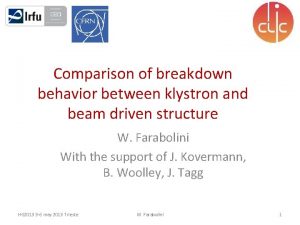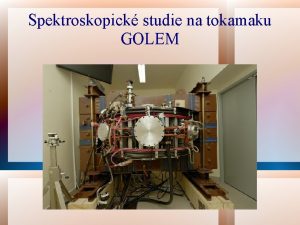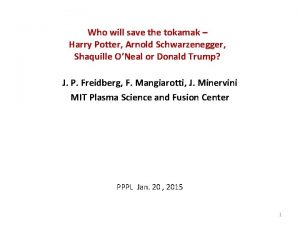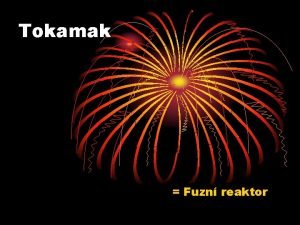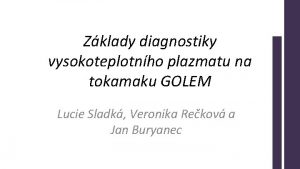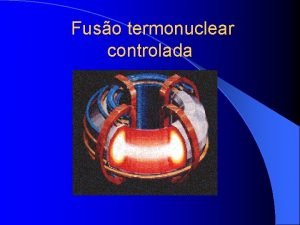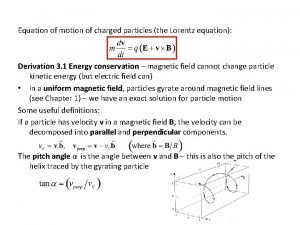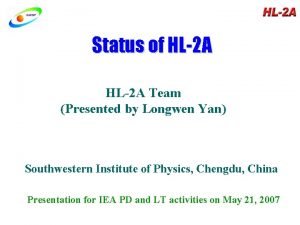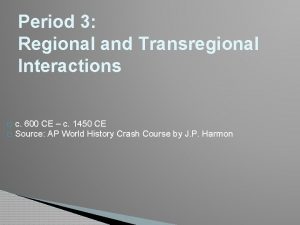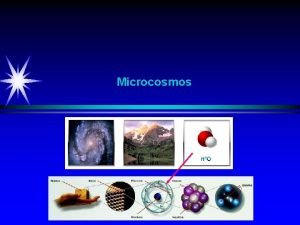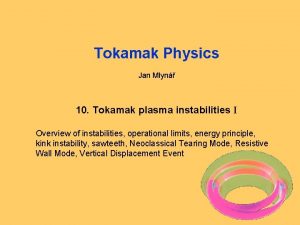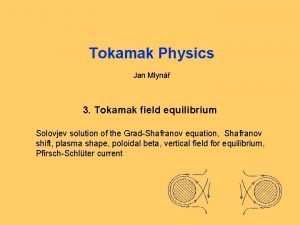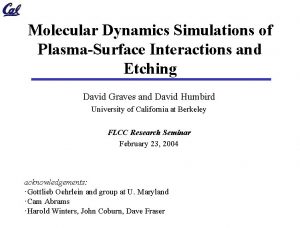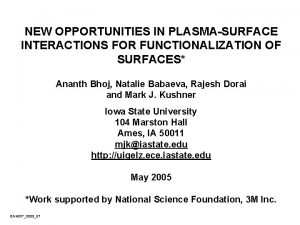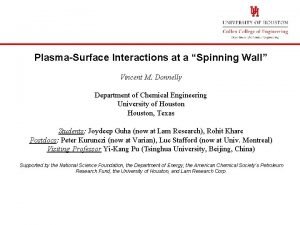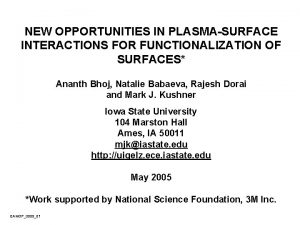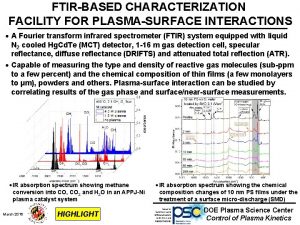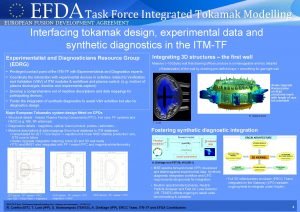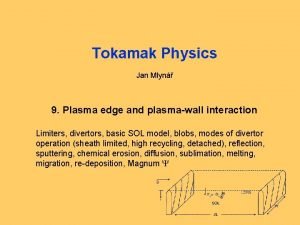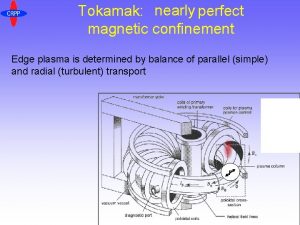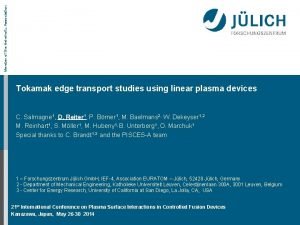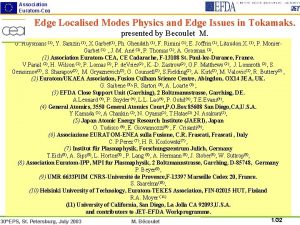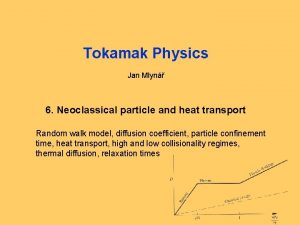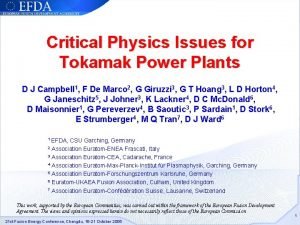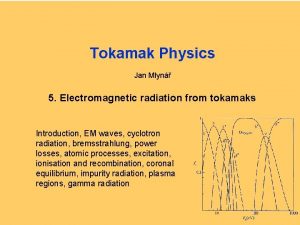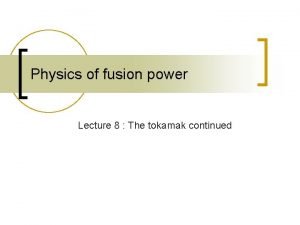Tokamak edge physics and plasmasurface interactions Richard A






![lq , l. T , ln Basics – SOL width, ln [1] B Main lq , l. T , ln Basics – SOL width, ln [1] B Main](https://slidetodoc.com/presentation_image_h/1941ea6b1493e018e53975a5fe8a7cc7/image-7.jpg)





![Divertor closure los gc sin rea Inc JET, R. D. Monk, et al. [13] Divertor closure los gc sin rea Inc JET, R. D. Monk, et al. [13]](https://slidetodoc.com/presentation_image_h/1941ea6b1493e018e53975a5fe8a7cc7/image-13.jpg)

![Impurity seeding JET, G. F. Matthews et al. [16] DIII-D, C. J. Lasnier, et Impurity seeding JET, G. F. Matthews et al. [16] DIII-D, C. J. Lasnier, et](https://slidetodoc.com/presentation_image_h/1941ea6b1493e018e53975a5fe8a7cc7/image-15.jpg)







![Erosion: Physical and chemical sputtering Physical Chemical (carbon) Adapted from Eckstein et al. [20] Erosion: Physical and chemical sputtering Physical Chemical (carbon) Adapted from Eckstein et al. [20]](https://slidetodoc.com/presentation_image_h/1941ea6b1493e018e53975a5fe8a7cc7/image-23.jpg)









![References (2) [15] “Study of target plate heat load in diverted DIII-D tokamak discharges”, References (2) [15] “Study of target plate heat load in diverted DIII-D tokamak discharges”,](https://slidetodoc.com/presentation_image_h/1941ea6b1493e018e53975a5fe8a7cc7/image-33.jpg)
![References (3) [32] “Material migration in divertor tokamaks”, G. F. Matthews et al. , References (3) [32] “Material migration in divertor tokamaks”, G. F. Matthews et al. ,](https://slidetodoc.com/presentation_image_h/1941ea6b1493e018e53975a5fe8a7cc7/image-34.jpg)


- Slides: 36

Tokamak edge physics and plasmasurface interactions Richard A. Pitts Centre de Recherches en Physique des Plasmas Ecole Polytechnique Fédérale de Lausanne, Switzerland Association EURATOM-Swiss Confederation Hungarian Plasma Physics and Fusion Technology Workshop, Győr, Hungary, 26/03/2008 R. A. Pitts

“Mission statement” for this talk … “The interaction of plasma with first wall surfaces will have a considerable impact on the performance of fusion plasmas, the lifetime of plasma-facing components and the retention of tritium in next step burning plasma experiments” Progress in the ITER Physics Basis, Chap. 4: “Power and particle control”, Nucl. Fusion 47 (2007) S 203 -S 263 2 Hungarian Plasma Physics and Fusion Technology Workshop, Győr, Hungary, 26/03/2008 R. A. Pitts

Outline • The scrape-off layer (SOL) and divertor − SOL power width − Divertor detachment − SOL flows • Plasma-surface interactions − Material lifetime – erosion and migration − Tritium retention − Dust − Mixed materials CAVEAT: Edge plasma physics and PSI is a vast domain. Can only scratch the surface in a single tutorial. Work referenced throughout the talk is listed at the end. 3 Hungarian Plasma Physics and Fusion Technology Workshop, Győr, Hungary, 26/03/2008 R. A. Pitts

Divertor and SOL physics 4 Hungarian Plasma Physics and Fusion Technology Workshop, Győr, Hungary, 26/03/2008 R. A. Pitts

Terminology: limiters and divertors Scrape-off layer (SOL) plasma: region of open field lines CL LCFS “Upstream” Core plasma Outer midplane t ra pa Se rix Limiter Vessel walls 5 X-point Private plasma Inner Outer Divertor targets Hungarian Plasma Physics and Fusion Technology Workshop, Győr, Hungary, 26/03/2008 R. A. Pitts

e. g. Limiter and divertor phases in many JET shots JET #62218, H-mode, Ip = 3. 0 MA, Bj = 3. 0 T Ramp-up and ramp-down phases in ITER will be in limited phase, ~30 s long [5]. Full burn divertor phase of ~400 s for the QDT = 10 inductive scenario 6 Hungarian Plasma Physics and Fusion Technology Workshop, Győr, Hungary, 26/03/2008 R. A. Pitts
![lq l T ln Basics SOL width ln 1 B Main lq , l. T , ln Basics – SOL width, ln [1] B Main](https://slidetodoc.com/presentation_image_h/1941ea6b1493e018e53975a5fe8a7cc7/image-7.jpg)
lq , l. T , ln Basics – SOL width, ln [1] B Main plasma “upstream” Limiter or divertor plate SOL WALL 2 L Adapted from [1] “Connection length” • Quick and dirty estimate of ln with diffusive approx. for cross-field particle transport (all ionisation inside LCFS): G nv = -D dn/dr ~ D n/ ln v D /ln , ln= t v v|| cs ~ (k. T/mi)1/2 Then, if t = t||, 7 • Any solid surface inserted into a plasma constitutes a very strong particle sink • In the high tokamak B-field: G << G|| • Thin Debye sheath (l. D few 10’s mm thick ) forms at the surface controls flow of particles and energy || B e. g. L ~ 30 m (typical of JET): TLCFS ~ 100 e. V, cs ~ 105 ms-1, D ~ 1 m 2 s-1 (near SOL) ln~ 1. 7 cm!! cf. minor radus = 2. 0 m for ITER Even worse for energy – see next …… Hungarian Plasma Physics and Fusion Technology Workshop, Győr, Hungary, 26/03/2008 R. A. Pitts

The problem with lq • • SOL width for power, lq, is also small and is an important parameter of the edge plasma As for particles, lq is determined by the ratio of to || transport (e. g. cross-field ion conduction and parallel electron conduction: i. e. ( / ||)1/2 ), where is anomalous Scalings for lq can be derived from models and experiments, e. g. : − “ 2 -point” analytic modelling: PSOL = power into SOL [1] − Scaling from H-mode experiments on JET [6]: − ITER modelling [7] assumes lq = 5 mm, JET scaling gives lq = 3. 7 mm (cf. a=2. 0 m) − Very recent multi-machine scaling [8] gives lq/R ~ constant Note also that the parallel power flux, q|| PSOL/lq ~ as much as 1 GWm-2 in ITER Stored energy scales strongly with tokamak major radius, W ~ R 4 [9] But power deposition area in the divertor Rlq only (~3. 0 m 2 in ITER) Bottom line is that despite its increased physical size, ITER will concentrate more power into a narrower channel at the plasma edge than today’s devices. The use of divertor detachment, radiation and geometry will be used to reduce the surface power flux densities to manageable levels, but careful monitoring will be critical (unlike today’s expts. , where it is “useful”) 8 Hungarian Plasma Physics and Fusion Technology Workshop, Győr, Hungary, 26/03/2008 R. A. Pitts

Power handling – ITER case (approx) lq = 5 mm ~100 MW q||, u ~ 500 MWm-2 SO L CORE PLASMA a • Max. steady-state power flux density permitted at ITER divertor targets: q 10 MWm-2 • Magnetic and divertor geometry alone cannot reduce the power to Magnetic flux expansion tolerable levels ~(Bq/B)u/(Bq/B)t ~4 for ITER outer • Most of the parallel power divertor low field line angles flux must be prevented from at strike points (~3º) reaching the plates + divertor detachment and Target tilting in poloidal plane high radiative loss (a ~ 25º for ITER outer target) per target (adapted from [10]) 9 q ~ 25 MWm-2 per target if no radiative (or other) dissipation Hungarian Plasma Physics and Fusion Technology Workshop, Győr, Hungary, 26/03/2008 R. A. Pitts

The route to detachment (1) Low n, high T (high PSOL) “Sheath limited” T Target n L u t Moderate n, T “High recycling” T Target n Region of strong radiation losses L u 10 Mean free paths for particle collisions are long: SOL collisionality: is low Power flow to surface largely controlled by target sheath: g = sheath heat transmission coefficient epot = potential energy per incident ion t n* rises as nu rises, finite electron heat conductivity: (note: k 0, e » k 0, i) allows parallel T gradients to develop Tt decreases, but pressure balance maintained ( p|| ~ 0) so that nt rises strongly ( ) lion ( 1/nt) decreases so that target recycling increases strongly flux amplification As Tt , radiation loss increases Tt further Hungarian Plasma Physics and Fusion Technology Workshop, Győr, Hungary, 26/03/2008 R. A. Pitts

The route to detachment (2) High n “Detached” T Recycle region Target n u L Adapted from [2] C-Mod, B. Labombard, et al. , [11] 11 t At sufficiently low Tt, (< 5 e. V), neutral ionisation rate < ion-neutral friction processes (CX, elastic scattering). Momentum transferred from ions to dense cloud of neutrals in front of the plate (recycle region) begins to reduce nt, p|| 0 and plasma pressure falls across recycle region. Once Tt ~1 -2 e. V (and if nt high enough), volume recombination locally “extinguishes” plasma, reducing target power flux Detachment seen experimentally in many devices, but complex “volumetric” process and relative importance of ion-momentum friction vs. recombination still unclear. X-point geometry long connection lengths high residence times in low Te plasma efficient radiative loss favouring power reductions where q|| is highest (i. e. on flux surfaces near separatrix). Hungarian Plasma Physics and Fusion Technology Workshop, Győr, Hungary, 26/03/2008 R. A. Pitts

Full detachment is a problem • Detachment which is too “strong” (particle flux reduced across the whole target) is often associated with zones of high radiation in the X-point region and confined plasma (MARFE) • MARFE formation can drive a transition from H to L-mode (Hmode density limit) or disruption • MARFE physics still not well modelled JET, A. Huber, et al. [12] Limit detachment to regions of highest power flux (where it is needed most). Maintain remainder of SOL in high recycling (attached) A few ways to arrange that this happens more readily: Divertor closure 12 Target orientation Hungarian Plasma Physics and Fusion Technology Workshop, Győr, Hungary, 26/03/2008 Impurity seeding R. A. Pitts
![Divertor closure los gc sin rea Inc JET R D Monk et al 13 Divertor closure los gc sin rea Inc JET, R. D. Monk, et al. [13]](https://slidetodoc.com/presentation_image_h/1941ea6b1493e018e53975a5fe8a7cc7/image-13.jpg)
Divertor closure los gc sin rea Inc JET, R. D. Monk, et al. [13] • Increased closure significantly improves divertor neutral pressure increased neutral density (nn), promoting earlier detachment • Closing “bypass” leaks important for increasing nn • Divertor closure also promotes helium compression and exhaust – very important for ITER and reactors 13 Hungarian Plasma Physics and Fusion Technology Workshop, Győr, Hungary, 26/03/2008 R. A. Pitts

Target orientation Increased ionisation near sep. rat pa Se Cooler, less dense plasma Separatrix • Parallel heat fluxes significantly reduced for vertical cf. horizontal targets • Underlying effect is preferential reflection of recycled deuterium neutrals towards the separatrix AUG, A. Kallenbach, et al. [14] rix Higher nt, lower Tt Hotter plasma near separatrix Higher CX losses Pressure loss q|| 14 Hungarian Plasma Physics and Fusion Technology Workshop, Győr, Hungary, 26/03/2008 R. A. Pitts
![Impurity seeding JET G F Matthews et al 16 DIIID C J Lasnier et Impurity seeding JET, G. F. Matthews et al. [16] DIII-D, C. J. Lasnier, et](https://slidetodoc.com/presentation_image_h/1941ea6b1493e018e53975a5fe8a7cc7/image-15.jpg)
Impurity seeding JET, G. F. Matthews et al. [16] DIII-D, C. J. Lasnier, et al. [15] Unfuelled D 2 puff 92 torrls-1 for 1. 8 s Strong D 2 puff Ne puff 12 torrls-1 for 0. 1 s Strong D 2 +N 2 puff Strong impurity seeding also reduces ELM size but high price can be paid in confinement 15 Hungarian Plasma Physics and Fusion Technology Workshop, Győr, Hungary, 26/03/2008 R. A. Pitts

ITER divertor achieves partial detachment Outer strike pt. Power load (Wm-2) Inner strike pt. ITER Divertor DDD 17, Case 489 (SOLPS 5 runs by A. Kukushkin) Kirschner et al. [17] 16 Deep V-shaped divertor, vertical, inclined targets Dome separating inner and outer targets – also helpful for diagnostics, neutron shielding and reducing neutral reflux to the core Hungarian Plasma Physics and Fusion Technology Workshop, Győr, Hungary, 26/03/2008 R. A. Pitts

Divertor exhaust Apart from power handling, primary function of divertor is to deal with He from fusion reactions compress D, T, and He exhaust as much as possible for efficient pumping (and therefore also good density control). Critical criterion for an ITER burning plasma is that He is removed fast enough such that: is satisfied. is the global helium particle residence time – a function of tp, the He neutral density in the divertor and the pumping speed (conductance) [18]. Helium enrichment: is the ratio of He concentration in the divertor compared to the main plasma. 17 To cryopumps e. g. ITER: He prod. rate ~2 1020 s-1 Max. divertor pumping speed ~200 Pa m 3 s-1 ~ 1 1023 He atom s-1 Cpump ~ 2 10 -3 = 0. 2% Typical acceptable He conc. in the core: ~4% h. He = 0. 2/4 = 0. 05 is minimum required. The values of and required for ITER have been achieved experimentally Hungarian Plasma Physics and Fusion Technology Workshop, Győr, Hungary, 26/03/2008 R. A. Pitts

Plasma-surface interactions 18 Hungarian Plasma Physics and Fusion Technology Workshop, Győr, Hungary, 26/03/2008 R. A. Pitts

Upscale to ITER is a big step Extracted from G. F. Matthews et al. [19] Parameter Integral time in diverted phase Number of pulses Energy Input Average power Divertor ion fluence JET Mk. IIGB (1999 -2001) 14 hours 5748 220 GJ 4. 5 MW 1. 8 x 1027 ITER 0. 1 hours 1 60 GJ 150 MW *6 x 1027 *Code calculation 1 ITER pulse ~ 0. 5 JET years energy input 1 ITER pulse ~ 6 JET years divertor fluence 19 Hungarian Plasma Physics and Fusion Technology Workshop, Győr, Hungary, 26/03/2008 R. A. Pitts

ITER materials choices • Be for the first wall • For H and part of D − Low T-retention phase: C for the targets − Low Z − Good oxygen getter W − Low Z − Does not melt − Excellent radiator • W for the dome/baffles − High Yphys threshold Beryllium Driven by the need for operational flexibility • For D and DT phases: − Be wall, all-W divertor To avoid problem of T-retention CFC 20 What are the issues associated with plasma-surface interactions? Hungarian Plasma Physics and Fusion Technology Workshop, Győr, Hungary, 26/03/2008 R. A. Pitts

Critical issues Long term tritium retention Short and long range material migration Material mixing Steady state erosion All strongly interlinked Transient erosion (ELMs, disruptions) Material lifetime 21 Redeposition Hungarian Plasma Physics and Fusion Technology Workshop, Győr, Hungary, 26/03/2008 R. A. Pitts

Impurity migration Migration = Erosion 22 Transport Deposition Re-erosion Hungarian Plasma Physics and Fusion Technology Workshop, Győr, Hungary, 26/03/2008 R. A. Pitts
![Erosion Physical and chemical sputtering Physical Chemical carbon Adapted from Eckstein et al 20 Erosion: Physical and chemical sputtering Physical Chemical (carbon) Adapted from Eckstein et al. [20]](https://slidetodoc.com/presentation_image_h/1941ea6b1493e018e53975a5fe8a7cc7/image-23.jpg)
Erosion: Physical and chemical sputtering Physical Chemical (carbon) Adapted from Eckstein et al. [20] Roth et al. [21] ITER divertor flux D impact • Energy threshold higher for higher Z substrate • Much higher yields for high Z projectiles – important if using impurity seed gases 23 • No threshold • Dependent on bombarding energy, flux and surface temperature Current steady state divertor target erosion rates (ERO modelling) due to Yphys and Ychem estimated at ~0. 4 - 2 nms-1 for ITER [17] Hungarian Plasma Physics and Fusion Technology Workshop, Győr, Hungary, 26/03/2008 R. A. Pitts

Erosion: transients, e. g. ELMs on the divertor Important factor is max. DTsurf due to arrival of short heat pulse (duration, t): Important to measure Tmax f = fraction of Wth lost during transient Adiv, divertor wetted area r, k, C=density, conductivity, heat capacity ELM energy losses must stay below melting/sublimation/evaporation limit to avoid fast erosion (e. g. melt later loss) Time (ms) Federici et al. [22] If Dtransient ~ few mm and target thickness ~ cm lifetime ~104 events ~103 Type I ELMs/discharge lifetime ~ 10 ITER pulses!! BUT: tests on ITER target mock-ups with realistic energy fluxes show that damage threshold ~2 x lower than for ideal materials (crack formation on W, PAN fibre erosion in CFC) [23, 24] Need to keep ELM energy flux 0. 5 MJm-2 for W and CFC 24 Hungarian Plasma Physics and Fusion Technology Workshop, Győr, Hungary, 26/03/2008 R. A. Pitts

Erosion: ELM size must be mitigated in ITER Materials tests (QSPA and MK-200 UG plasma gun facilities in RF) show that CFC PAN fibre erosion and W surface cracking do not occur for energy densities 0. 5 MJm-2 for ~500 ms, triangular pulse lengths (250 ms up and down). How does this convert to an ITER tolerable ELM size [25]? What do we know about ELMs at the divertor target? 1) Rise time to peak Tsurf ~ t|| [26] (t|| = cs/L ~ 250 ms for ITER) 2) Toroidal peaking factor ~ 1 [27] 3) lq, ELM ~ lq, inter-ELM ~ 5 mm (ITER) 4) A , IN = 1. 4 m 2, A , OUT = 1. 9 m 2 5) No ELM energy to main walls 6) Strong in-out asymmetry in ELM power loading (not understood yet) DWELM = q. ELM A , in (1 + Eout/Ein) = 0. 5 MJ/m 2 1. 4 m 2 1. 5 ~ 1 MJ This is only ~0. 3% of plasma stored energy for ITER QDT = 10 baseline scenario! Natural Type I ELMs this small do not exist And note that ELMs have a size distribution! Mitigation techniques will be required in ITER (e. g. pellet pacing (see talk by P. Lang), active ergodisation coils [30, 31]) 25 JET Eich, Pitts [28, 29] Hungarian Plasma Physics and Fusion Technology Workshop, Győr, Hungary, 26/03/2008 R. A. Pitts

Transport creates and moves impurities Ions: D 0 from wall ion flux or gas puff Cross-field transport – turbulent driven ion fluxes can extend into far SOL recycled neutrals direct impurity release ELMs can also reach first walls CX event Eroded Impurity ions “leak” out of the divertor ( Ti forces) SOL and divertor ion fluid flows can entrain impurities Ionisation Neutrals: • From divertor plasma leakage, gas puffs, bypass leaks low energy CX fluxes wall sputtering • Lower fluxes of energetic D 0 from deeper in the core plasma • A problem for first mirrors see talk by A. H. Donne 26 Bypass leaks Hungarian Plasma Physics and Fusion Technology Workshop, Győr, Hungary, 26/03/2008 Escape via divertor plasma EDGE 2 D/NIMBUS R. A. Pitts

Migration balance – example from JET • Make balance for period 1999 -2001 with Mark. IIGB divertor: 14 hours plasma in diverted phase (50400 s, 5748 shots) • Use spectroscopy and modelling to estimate main chamber sources • Post mortem surface analysis − Deposition almost all at inner divertor − Surface layers are Be rich C chemically eroded and migrates, Be stays put − Outer divertor – region of net erosion or balanced erosion/redeposition – BUT mostly attached conditions (not like ITER) ~250 kg/year if JET operated full time! Carbon migrates to remote locations forming D-rich soft layers (high Tretention) 27 20 g Be (Be. II) 450 g C (CIII) Main chamber: source of net erosion ~400 g C 22 g Be Hungarian Plasma Physics and Fusion Technology Workshop, Győr, Hungary, 26/03/2008 Pitts et al. [4] Matthews et al. [32] Strachan et al. [33] Likonen et al. [34] R. A. Pitts

Tritium retention (1) • One of the most challenging operational issues for burning plasmas • If carbon present, complex interplay between erosion hydrocarbons dissociation/ionisation transport re-deposition migration to remote areas with high sticking coefficients and retention in co-deposits − Carbon traps D, T very efficiently − D/C ratio can be in the range ~0. 4 > 1 depending on the type of re-deposited layer • Retention very hard to characterise in today’s mostly carbon dominated devices • Dependent on materials, Tsurf, geometry (limiter/divertor), operating scenarios (Hmode, L-mode, low/high dens. ) 28 Reported measurements range from 3 -50% retention [35]! e. g. on JET, ~3% obtained from long term, post mortem surface analysis, ~10 -20% from gas balance. Hungarian Plasma Physics and Fusion Technology Workshop, Győr, Hungary, 26/03/2008 R. A. Pitts

Tritium retention (2) • A 400 s QDT = 10 ITER discharge will require ~50 g of T fuelling (cf. 0. 01 -0. 2 g in today’s tokamaks) • Working guideline for max. in-vess. mobilisable T in ITER ~1 kg [18, 36] • World supply of T is also limited − Must avoid build-up in inaccessible locations • Predicting the expected retention in ITER is notoriously difficult ITER target [18] is a retention level of ~0. 05 g/discharge ~7000 shots before major shutdown for T-removal Accurate measurement of T-retention and the development of efficient Tremoval methods will be critical for the success of ITER 29 C targets, Tsurf = 800ºC, chemical+physical sputtering e rg ha sc i g/d ~2 ~0. 02 g/discharge Roth et al. [37] • Very recent estimates (ERO code 2007 including Be main chamber influx) show that the in-vessel limit could be reached after only ~140 shots [17] − Modelling does not yet contain effects of transients (ELMs disruptions)! − No account taken for trapping in tile gaps Hungarian Plasma Physics and Fusion Technology Workshop, Győr, Hungary, 26/03/2008 R. A. Pitts

Dust • Dust is seen in all tokamaks, especially with C walls • Not generally a concern in today’s devices … • But is potentially very important in ITER − As an inventory for trapped tritium in areas difficult to access − As an explosive safety hasard – water leak hot surfaces steam hydrogen (by oxidation) possible explosion if enough air also present [38] − As a radiological or toxic hasard (activation products of W, tritium contained in Be, C dust, toxicity of Be dust) TCV: floor viewing IR camera during disruption, #33448 (J. Marki, R. A. Pitts Carbon dust collected from tokamaks after operation periods is usually micron sized. Formed from flaking and degradation of deposited films, unipolar arcing, brittle fracture (e. g. due to transients) etc. No real idea yet how much dust ITER will generate, where it will go or how to get it out a big effort needed to improve this situation 30 DIII-D: floor viewing Di. MES TV with near IR filter. 2 nd shot in 2007 after “dirty vent”, #127331. Courtesy of D. L. Rudakov & W. P. West [39] Hungarian Plasma Physics and Fusion Technology Workshop, Győr, Hungary, 26/03/2008 R. A. Pitts

Mixed Materials No fusion device operating today contains the material mix currently planned for the ITER first wall and divertor: Be, W, C. Cross contamination of the material surfaces will be unavoidable. This is likely to have several consequences [18]: Material property changes due to mixing • Formation of metallic carbides diffusion of C into bulk material at high temperatures • Formation of Be-W alloys melting point can be reduced by as much as ~2000ºC Effect on H-isotope retention • Retention of H in Be. O can be as high as in C • Retention in W can be increased by C or oxide layers but is very low in pure W or Be • Very complex – difficult to predict yet for ITER Effect on material erosion • Can both increase and decrease erosion! • Heavy ions (e. g. Be. Z+, CZ+) on C, W increased phys. sputt. but surface coverage (e. g. Be on C) reduces chemical sputtering. Preparations underway at JET to test a Be/W & Be/W/C wall mix from ~2011 [40] 31 Hungarian Plasma Physics and Fusion Technology Workshop, Győr, Hungary, 26/03/2008 R. A. Pitts

References (1) A 40 min. talk can only hope to scratch the surface of such a vast field. Some good reference sources covering aspects of the material shown in this presentation are the following: [1] “The plasma boundary of magnetic fusion devices”, P. C. Stangeby, Io. P Publishing Ltd, Bristol, 2000 [2] “Experimental divertor physics”, C. S. Pitcher and P. C. Stangeby, Plasma Phys. Control. Fusion 39 (1997) 779 [3] “Plasma-material interactions in current tokamaks and their implications for next step fusion reactors”, G. Federici et al. , Nucl. Fusion 39 (1997) 79 [4] “Material erosion and migration in tokamaks”, R. A. Pitts et al. , Plasma Phys. Control. Fusion 47 (205) B 303 A number of additional papers have been used to prepare the slides in this presentation. They are listed below in order of appearance in the talk. [5] “Simulations of ITER start-up and assessment of initial power loads”, G. Federici et al. , J. Nucl. Mater. 363 -365 (2007) 346 [6] “Boundary plasma energy transport in JET ELMy H-modes”, W. Fundamenski and W. Sailer, Nucl. Fusion 44 (2003) 20 [7] “Scaling laws for edge plasma parameters in ITER from two-dimensional edge modelling”, A. Kukushkin et al. , Nucl. Fusion 43 (2003) 716 [8] “Plasma-surface interaction, scrape-off layer and divertor physics: implications for ITER”, B. Lipschultz et al. , Nucl. Fusion 47 (2007) 1189 [9] “Steady state and transient power handling in JET”, G. F. Matthews et al. , Nucl. Fusion 43 (2003) 999 [10] “The plasma-wall interaction region: a key low temperature plasma for controlled fusion”, G. F. Counsell, Plasma Sources Sci. Technol. 11 (2002) A 80 [11] “Experimental investigation of transport phenomena in the scrape-off layer and divertor”, B. La. Bombard et al. , J. Nucl. Mater. 241 -243 (1997) 149 [12] “Improved radiation measurements on JET – first results from an upgraded bolometer system”, A. Huber et al. , J. Nucl. Mater. 363 -365 (2007) 365 [13] “Recent results from divertor and scrape-off layer studies on JET”, R. D. Monk et al. , Nucl. Fusion 39 (1999) 1751 [14] “Scrape-off layer radiation and heat load to the ASDEX Upgrade LYRA divertor”, A. Kallenbach et al. , Nucl. Fusion 39 (1999) 901 32 Hungarian Plasma Physics and Fusion Technology Workshop, Győr, Hungary, 26/03/2008 R. A. Pitts
![References 2 15 Study of target plate heat load in diverted DIIID tokamak discharges References (2) [15] “Study of target plate heat load in diverted DIII-D tokamak discharges”,](https://slidetodoc.com/presentation_image_h/1941ea6b1493e018e53975a5fe8a7cc7/image-33.jpg)
References (2) [15] “Study of target plate heat load in diverted DIII-D tokamak discharges”, C. Lasnier et al. , Nucl. Fusion 38 (1998) 1225 [16] “Studies in JET divertors of varied geometry: II Impurity seeded plasmas”, G. F. Matthews et al. , Nucl. Fusion 39 (1999) 19 [17] “Modelling of tritium retention and target lifetime of the ITER divertor using the ERO code”, A. Kirschner et al. , J. Nucl. Mater. 363 -365 (2007) 91 [18] “ITER Physics basis: Chapter 4, power and particle control”, Nucl. Fusion 39 (1999) 2391 [19] “Material migration in JET”, G. F. Matthews et al. , Proc. 30 th EPS Conf. on Control. Fusion and Plasma Physics (St. Petersburg, 2003) 27 A (ECA) P-3. 198 [20] W. Eckstein et al. , IPP Garching report number 9/82 (1993) [21] “Flux dependence of carbon chemical erosion by deuterium ions”, J. Roth et al. , Nucl. Fusion 44 (2004) L 21 [22] “Assessment of the erosion of the ITER divertor targets during Type I ELMs”, G. Federici et al. , Plasma Phys. Control. Fusion 45 (2003) 1523 [23] “Transient energy fluxes in tokamaks : Physical processes and consequences for next step devices”, A. Loarte et al. , 34 th EPS Conf. on Control. Fusion and Plasma Physics (Warsaw, 2007) [24] “Effect of ELMs on ITER divertor armour materials”, A. Zhitlukhin et al. , J. Nucl. Mater. 363 -365 (2007) 301 [25] A. Loarte et al. , to be presented at 22 nd IAEA Fusion Energy Conference, Geneva, Switzerland, October 2008 [26] “Power deposition onto plasma-facing components in poloidal divertor tokamaks during Type I ELMs and disruptions”, T. Eich et al. , J. Nucl. Mat. 337 -339 (2005) 669 [27] “Characteristics of Type I ELM energy and particle losses in existing devices and their extrapolation to ITER”, A. Loarte et al. , Plasma Phys. Control. Fusion 45 (2003) 1549 [28] “Divertor power deposition and target current asymmetries during Type I ELMs in ASDEX Upgrade and JET”, T. Eich et al. , J. Nucl. Mat. 363 -365 (2007) 989 [29] “ELM transport in the JET Scrape-off layer”, R. A. Pitts et al. , Nucl. Fusion 47 (2007) 1437 [30] “Suppression of large Edge-Localised Modes in high confinement DIII-D plasmas with a stochastic magnetic boundary”, T. E. Evans et al. , Phys. Rev. Lett. 92 (2004) 235003 [31] “Active control of Type I Edge-Localised Modes with n= 1 perturbation fields in the JET tokamak”, Y. Liang et al. , Phys. Rev. Lett. 98 (2007) 265004 33 Hungarian Plasma Physics and Fusion Technology Workshop, Győr, Hungary, 26/03/2008 R. A. Pitts
![References 3 32 Material migration in divertor tokamaks G F Matthews et al References (3) [32] “Material migration in divertor tokamaks”, G. F. Matthews et al. ,](https://slidetodoc.com/presentation_image_h/1941ea6b1493e018e53975a5fe8a7cc7/image-34.jpg)
References (3) [32] “Material migration in divertor tokamaks”, G. F. Matthews et al. , J. Nucl. Mater. 337 -339 (2005) 1 [33] “JET carbon screening experiments using methane gas puffing and its relation to intrinsic carbon impurities”, J. D. Strachan et al. , Nucl. Fusion 43 (2003) 922 [34] “Beryllium accumulation at the inner divertor of JET”, J. Likonen et al. , J. Nucl. Mater. 337 -339 (2005) 60 [35] “Gas balance and fuel retention in fusion devices”, T. Loarer et al. , Nucl. Fusion 47 (2007) 1112 [36] “Overview of goals and performance of ITER and strategy for plasma-wall interaction investigation”, M. Shimada et al. , J. Nucl. Mater. 337 -339 (2005) 808 [37] “Flux dependence of carbon erosion and implications for ITER”, J. Roth et al. , J. Nucl. Mater. 337 -339 (2005) 970 [38] “The safety implications of tokamak dust size and surface area”, K. A. Mc. Carthy et al. , Fus. Eng. Design 42 (1998) 45 [39] “Observations of Dust in DIII-D Divertor and SOL”, D. L. Rudakov et al. , 1 st Workshop on “Dust in Fusion Plasmas”, 8 -10 July 2007, Warsaw, Poland [40] “An ITER-like wall for JET”, J. Pamela et al. , J. Nucl. Mater. 363 -365 (2007) 1 34 Hungarian Plasma Physics and Fusion Technology Workshop, Győr, Hungary, 26/03/2008 R. A. Pitts

Reserve slides 35 Hungarian Plasma Physics and Fusion Technology Workshop, Győr, Hungary, 26/03/2008 R. A. Pitts

Edge Diagnostics on ITER will be critical ne Prad ne, Te, Prad, position of ionisation front, n. He, n. D/n. T, impurity and D, T influxes Courtesy of A. Kukushkin Te Wall temperature and visible image Main chamber gas pressure and gas composition SOL neutral density (D/T) Impurity influxes SOL ne, Te profiles (but challenging) Cryopump inlet composition (H/D/T/He, Cx. Hy) Target plate heat and particle fluxes, Te, Neutral gas surface temperature, pressure erosion rate Dust accumulation? See talk 36 by A. H. Donne Hungarian Plasma Physics and Fusion Technology Workshop, Győr, Hungary, 26/03/2008 R. A. Pitts
 Rising edge and falling edge
Rising edge and falling edge Tokamak golem
Tokamak golem Harry potter arnold
Harry potter arnold Fuzn
Fuzn Tokamak működése
Tokamak működése Tokamak
Tokamak Hl2m tokamak
Hl2m tokamak Tokamak
Tokamak Equation of motion
Equation of motion Hl2 tokamak
Hl2 tokamak Richard iii pursuit of power
Richard iii pursuit of power Accounting information system chapter 1
Accounting information system chapter 1 Qualitative vs quantitative variable
Qualitative vs quantitative variable Contractionary fiscal policy interest rate
Contractionary fiscal policy interest rate The properties and interactions of magnets
The properties and interactions of magnets Geosphere and biosphere interactions
Geosphere and biosphere interactions Habitats niches and species interactions
Habitats niches and species interactions Examples of integral product architecture
Examples of integral product architecture Discuss the factors influencing communication
Discuss the factors influencing communication Symbiosis and species interactions keystone webquest
Symbiosis and species interactions keystone webquest Naive bayes pays attention to complex interactions and
Naive bayes pays attention to complex interactions and Modular architecture vs integrated architecture
Modular architecture vs integrated architecture Niches and community interactions
Niches and community interactions Regional and transregional interactions
Regional and transregional interactions Microcosmos macrocosmos
Microcosmos macrocosmos Regional and transregional interactions
Regional and transregional interactions Why does it happen
Why does it happen University physics with modern physics fifteenth edition
University physics with modern physics fifteenth edition Physics ia sample
Physics ia sample Noncovalent interactions
Noncovalent interactions Congress formal and informal powers
Congress formal and informal powers Competition symbiotic relationship
Competition symbiotic relationship Example of commensalism
Example of commensalism Sertraline interactions
Sertraline interactions Grapefruit-drug interactions chart
Grapefruit-drug interactions chart Interactions in the environment grade 7
Interactions in the environment grade 7 What are abiotic factors
What are abiotic factors
